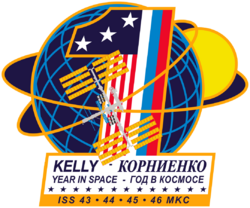Astronomy:ISS year long mission
The One-Year Mission was a scientific research project aboard the International Space Station, which studied the health effects of long-term spaceflight.[1] Scott Kelly and Mikhail Korniyenko spent 342 days (11 months, 3 days) in space, with scientists performing medical experiments. Kelly and Kornienko launched on 27 March 2015 on Soyuz TMA-16M along with Gennady Padalka.[2][3][4][5] The mission encompassed Expeditions 43, 44, 45 and 46.[6] The pair safely landed in Kazakhstan on March 2, 2016, returning aboard Soyuz TMA-18M with Sergey Volkov.[7] The mission supported the NASA Twins study, which helps shed light on the health effects of long duration spaceflight, which is of interest for Mars missions especially.[8]
History

In November 2012, NASA, the Russian Federal Space Agency (Roscosmos), and their international partners selected two veteran spacefarers for a one-year mission aboard the International Space Station in 2015. The mission included collecting scientific data important to future human exploration of the Solar System. Kelly and Korniyenko already had a connection; Kelly was a backup crew member for the station's Expedition 23/24 crews, where Korniyenko served as a flight engineer.
The goal aboard the orbiting laboratory was to understand better how the human body reacts and adapts to the harsh environment of space.[6] Data from the 342 days was intended to help inform current assessments of crew performance and health and determine better and validate countermeasures to reduce the risks associated with future exploration as NASA plans for missions around the Moon, asteroids and ultimately Mars.[10]
Health studies
The International Space Station developed exercise equipment, including treadmills and resistance devices to limit muscle atrophy in a low gravity environment. Weightlessness causes body fluids in astronauts to accumulate in the upper half of the body, leading to facial edema and unwelcome side effects. One problem may be the low gravity affecting the body in unforeseen ways and it can be hard detect the cause and effect of gravity on the body. Space seems to cause trouble for a number of body parts including bone, sometimes the eyes, and a classic problem is space sickness.
Psychological studies
The study also required the astronauts to keep a journal, and investigated the psychological effects of living in a confined space for an extended length of time. Kornienko said of his experiences on Expedition 23/24: "The thing you miss there most of all is the Earth itself, I missed smells. I missed trees, I even dreamt of them. I even hallucinated. I thought I smelled a real fire and something being barbecued on it! I ended up putting pictures of trees on the walls to cheer up. You do miss the Earth there."[11]
Scott stated that he missed feeling changes in the weather while on the ISS.[12]
History
Vladimir Titov and Musa Manarov spent 365 days in space on Mir from December 1987 to December 1988. Sergei Avdeyev spent 379 days on Mir in 1999 and Valeri Polyakov spent 437 days on Mir in 1994-1995.[13][14]
Prior to the Year Long Mission, the longest mission on the ISS was 215 days, by Mikhail Tyurin and Michael López-Alegría. Peggy Whitson holds the record for the longest single spaceflight by a woman at around 290 days.[15]
See also
- Scientific research on the International Space Station
- Timeline of longest spaceflights
- Spaceflight records
- Human mission to Mars
References
- ↑ Jeffrey Kluger (18 Dec 2014). "Meet the Twins Unlocking the Secrets of Space: NASA's One-Year Mission with Mark and Scott Kelly". Time. http://time.com/meet-the-twins-unlocking-the-secrets-of-space/. Retrieved 2015-12-14.
- ↑ "Historic yearlong mission crew launches to space station on Soyuz TMA-16M". collectSPACE. 27 March 2015. http://www.collectspace.com/news/news-032715a-tma16m-yearlong-station-launch.html. Retrieved 2015-12-14.
- ↑ AFP (27 March 2015). "Soyuz spacecraft with Russian, US astronauts blasts off for year-long mission". Australian Broadcasting Corporation. http://www.abc.net.au/news/2015-03-28/spacecraft-blasts-off-for-iss/6355252. Retrieved 2015-12-14.
- ↑ Brooks Hays (27 March 2015). "Soyuz rocket launches yearlong space station crew". United Press International. http://www.upi.com/Science_News/2015/03/27/Soyuz-rocket-prepares-to-launch-yearlong-space-station-crew/9511427480890/. Retrieved 2015-12-14.
- ↑ Irene Klotz (27 March 2015). "U.S., Russian crew blasts off for year-long stay on space station". Reuters. https://www.reuters.com/article/2015/03/27/space-station-year-launch-idUSL2N0WT22920150327. Retrieved 2015-12-14.
- ↑ 6.0 6.1 Jason Davis (25 March 2015). "One-Year ISS Mission Preview: 28 Experiments, 4 Expeditions and 2 Crew Members". The Planetary Society. http://www.planetary.org/blogs/jason-davis/2015/20150325-one-year-iss-preview.html. Retrieved 2015-12-14.
- ↑ "One-Year Crew Returns from Space Station March 1; Live Coverage on NASA TV". Nasa.gov. 2016-02-24. https://www.nasa.gov/press-release/one-year-crew-returns-from-space-station-march-1-live-coverage-on-nasa-tv. Retrieved 2016-02-25.
- ↑ Gushanas, Timothy (2017-01-30). "First Look at Findings of NASA Twins Study" (in en). NASA. https://www.nasa.gov/feature/how-stressful-will-a-trip-to-mars-be-on-the-human-body-we-now-have-a-peek-into-what-the-nasa.
- ↑ Eric Berger (20 March 2015). "Year-long mission the next step for Kelly, NASA". http://www.houstonchronicle.com/news/houston-texas/houston/article/Astronaut-Scott-Kelly-set-to-spend-a-year-in-space-6148612.php?t=3f8bca590e. Retrieved 2015-12-14.
- ↑ "NASA, Roscosmos Assign Veteran Crew to Yearlong Space Station Mission". NASA. 26 November 2012. http://www.nasa.gov/home/hqnews/2012/nov/HQ_12-406_ISS_1-Year_Crew.html. Retrieved 2012-11-26.
- ↑ Chris Arridge (12 September 2015). "Record-breaking astronauts return to Earth – taking us one step closer to Mars". The Conversation. http://theconversation.com/record-breaking-astronauts-return-to-earth-taking-us-one-step-closer-to-mars-47397. Retrieved 2015-12-14.
- ↑ "Crew of First Yearlong Expedition Aboard ISS Previews Mission". NASA/YouTube. 16 January 2015. https://www.youtube.com/watch?v=C7LDBvPTC20. Retrieved 2015-12-14.
- ↑ Schwirtz, Michael (30 March 2009). "Staying Put on Earth, Taking a Step to Mars". New York Times. https://www.nytimes.com/2009/03/31/science/space/31mars.html. Retrieved 2009-04-15.
- ↑ "Last Human to Spend a Year in Space Discusses Upcoming ISS One Year Mission". ReelNASA/YouTube. 26 March 2015. https://www.youtube.com/watch?v=bjUFRXmRGgk. Retrieved 2015-12-14.
- ↑ Becker, Joachim. "Astronaut Biography: Peggy Whitson". http://www.spacefacts.de/bios/astronauts/english/whitson_peggy.htm.
External links
- One-Year Mission - NASA
- NASA - One-Year Mission Investigators Debut Preliminary Results at NASA Workshop (January 30, 2017)




